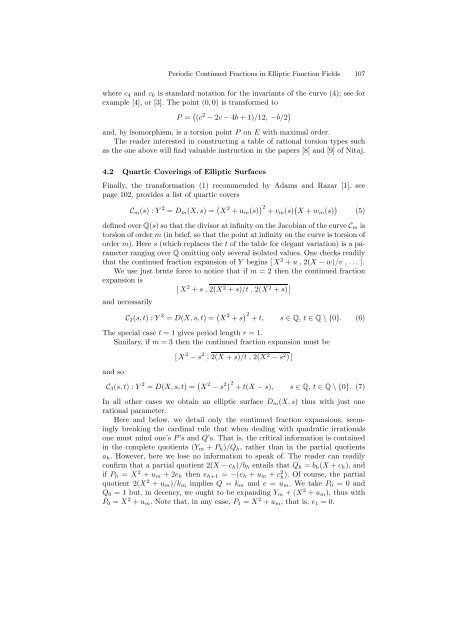Periodic Continued Fractions in Elliptic Function Fields - Macquarie ...
Periodic Continued Fractions in Elliptic Function Fields - Macquarie ...
Periodic Continued Fractions in Elliptic Function Fields - Macquarie ...
You also want an ePaper? Increase the reach of your titles
YUMPU automatically turns print PDFs into web optimized ePapers that Google loves.
<strong>Periodic</strong> <strong>Cont<strong>in</strong>ued</strong> <strong>Fractions</strong> <strong>in</strong> <strong>Elliptic</strong> <strong>Function</strong> <strong>Fields</strong> 107<br />
where c4 and c6 is standard notation for the <strong>in</strong>variants of the curve (4); see for<br />
example [4], or [3]. The po<strong>in</strong>t (0, 0) is transformed to<br />
P = (c 2 − 2c − 4b +1)/12, −b/2 <br />
and, by isomorphism, is a torsion po<strong>in</strong>t P on E with maximal order.<br />
The reader <strong>in</strong>terested <strong>in</strong> construct<strong>in</strong>g a table of rational torsion types such<br />
as the one above will f<strong>in</strong>d valuable <strong>in</strong>struction <strong>in</strong> the papers [8] and [9] of Nitaj.<br />
4.2 Quartic Cover<strong>in</strong>gs of <strong>Elliptic</strong> Surfaces<br />
F<strong>in</strong>ally, the transformation (1) recommended by Adams and Razar [1], see<br />
page 102, provides a list of quartic covers<br />
Cm(s) :Y 2 = Dm(X, s) = X 2 + um(s) 2 + vm(s) X + wm(s) <br />
(5)<br />
def<strong>in</strong>ed over Q(s)sothat the divisor at <strong>in</strong>f<strong>in</strong>ity on the Jacobian of the curve Cm is<br />
torsion of order m (<strong>in</strong> brief, so that the po<strong>in</strong>t at <strong>in</strong>f<strong>in</strong>ity on the curve is torsion of<br />
order m). Here s (which replaces the t of the table for elegant variation) is a parameter<br />
rang<strong>in</strong>g over Q omitt<strong>in</strong>g only several isolated values. One checks readily<br />
that the cont<strong>in</strong>ued fraction expansion of Y beg<strong>in</strong>s [ X 2 + u,2(X − w)/v , . . . ].<br />
We use just brute force to notice that if m =2then the cont<strong>in</strong>ued fraction<br />
expansion is<br />
[ X 2 + s,2(X 2 + s)/t , 2(X 2 + s)]<br />
and necessarily<br />
C2(s, t) :Y 2 = D(X, s, t) = X 2 + s 2 + t, s ∈ Q, t ∈ Q \{0}. (6)<br />
The special case t =1gives period length r =1.<br />
Similary, if m =3then the cont<strong>in</strong>ued fraction expansion must be<br />
and so<br />
[ X 2 − s 2 , 2(X + s)/t , 2(X 2 − s 2 )]<br />
C3(s, t) :Y 2 = D(X, s, t) = X 2 − s 2 2 + t(X − s), s ∈ Q, t ∈ Q \{0}. (7)<br />
In all other cases we obta<strong>in</strong> an elliptic surface Dm(X, s) thus with just one<br />
rational parameter.<br />
Here and below, we detail only the cont<strong>in</strong>ued fraction expansions, seem<strong>in</strong>gly<br />
break<strong>in</strong>g the card<strong>in</strong>al rule that when deal<strong>in</strong>g with quadratic irrationals<br />
one must m<strong>in</strong>d one’s P ’s and Q’s. That is, the critical <strong>in</strong>formation is conta<strong>in</strong>ed<br />
<strong>in</strong> the complete quotients (Ym + Ph)/Qh, rather than <strong>in</strong> the partial quotients<br />
ah. However, here we lose no <strong>in</strong>formation to speak of. The reader can readily<br />
confirm that a partial quotient 2(X − ch)/bh entails that Qh = bh(X + ch), and<br />
if Ph = X 2 + um +2eh then eh+1 = −(eh + um + c 2 h<br />
). Of course, the partial<br />
quotient 2(X 2 + um)/km implies Q = km and e = um. Wetake P0 =0and<br />
Q0 =1but, <strong>in</strong> decency, we ought to be expand<strong>in</strong>g Ym +(X 2 + um), thus with<br />
P0 = X 2 + um. Note that, <strong>in</strong> any case, P1 = X 2 + um, that is, e1 =0.

















